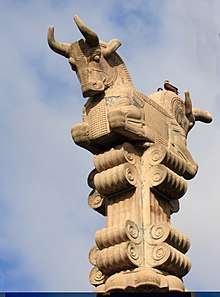Ganja, Azerbaijan
Ganja (/ˈɡændʒə/; Azerbaijani: Gəncə [ɟænˈd͡ʒæ]; Persian: گنجه) is Azerbaijan's second largest city, with a population of around 332,600.[1][2][3] It was named Elisabethpol (Russian: Елизаветпо́ль, tr. Yelizavetpól', IPA: [jɪlʲɪzəvʲɪtˈpolʲ]) in the Russian Empire period. The city regained its original name, Ganja, in 1920 during the first part of its incorporation into the Soviet Union. However, its name was changed again in 1935 to Kirovabad (Russian: Кироваба́д, IPA: [kʲɪrəvɐˈbat]) and retained that name through most of the rest of the Soviet period. In 1989, during perestroika, the city regained its original name.
Ganja Gəncə | |
|---|---|
City & Municipality | |
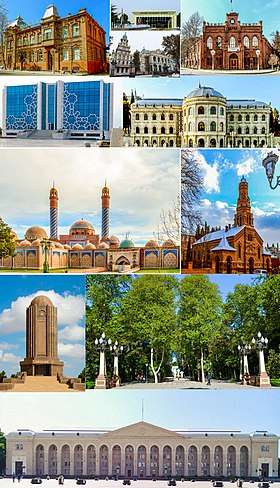 | |
 Seal | |
| Nickname(s): Red City | |
 Ganja | |
| Coordinates: 40°40′58″N 46°21′38″E | |
| Country | |
| Government | |
| • Mayor | Niyazi Bayramov |
| Area | |
| • Total | 170 km2 (70 sq mi) |
| Elevation | 408 m (1,339 ft) |
| Population (2018) | |
| • Total | 332,600 |
| • Density | 2,848/km2 (7,380/sq mi) |
| • Population Rank in Azerbaijan | 2nd |
| Demonym(s) | Gəncəli |
| Time zone | UTC+4 (GMT+4) |
| Area code(s) | (+994) 22 |
| Vehicle registration | 20 AZ |
| Website | www.ganca.net |
Etymology
Even though some sources from medieval Islamic time attribute the building of the town to a Muslim Arab ruler named Muhammad ibn Khalid, modern historians believe that the fact that the name Ganja derives from the New Persian ganj ("treasure") and in Arabic source the name is recorded as Janza (from the Middle Persian ganza) suggests that the city existed in pre-Islamic times and was likely founded in the 5th century.[4] According to some sources, it changed hands between Persians, Khazars and Arabs even in the 7th century.[5] The area in which Ganja is located was known as Arran from the 9th to 12th century; its urban population spoke mainly in the Persian language.[6][7]
History
Feudal era
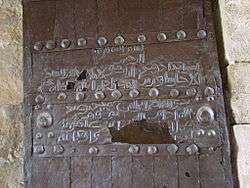
According to medieval Arabic sources, the city of Ganja was founded in 859-60 by Muhammad ibn Khalid ibn Yazid ibn Mazyad, the Arab governor of the region in the reign of the caliph al-Mutawakkil, and so-called because of a treasure unearthed there. According to the legend, the Arab governor had a dream where a voice told him that there was a treasure hidden under one of the three hills around the area where he camped. The voice told him to unearth it and use the money to found a city. He did so and informed the caliph about the money and the city. Caliph made Muhammad the hereditary governor of the city on a condition that he would give the money he found to the caliph.[8]
Foundation of the city by Arabs is confirmed by the medieval Armenian historian Movses Kagankatvatsi, who mentions that the city of Ganja was founded in 846–47 in the canton of Arshakashen by the son of Khazr Patgos, "a furious and merciless man".[9]
Historically an important city of the South Caucasus, Ganja has been part of the Sassanid empire, Great Seljuk Empire, Kingdom of Georgia, Atabegs of Azerbaijan, Khwarezmid Empire, Il-Khans,[10] Timurids,[11] Qara Qoyunlu,[12] Ak Koyunlu,[13][14] the Safavid, the Afsharid, the Zand and the Qajar empires of Persia/Iran. Prior to the Iranian Zand and Qajar rule, following Nader Shah's death, it was ruled locally for a few decades by the khans/dukes of the Ganja Khanate, who themselves were subordinate to the central rule in mainland Iran and were a branch of the Iranian Qajar family.[15][16] Ganja is also the birthplace of the famous poet Nizami Ganjavi.
.jpg)
.jpg)
The people of Ganja experienced a temporary cultural decline after an earthquake in 1139, when the city was taken by king Demetrius I of Georgia and its gates taken as trophies which is still kept in Georgia, and again after the Mongol invasion in 1231. The city was revived after the Safavids came to power in 1501, and incorporated all of Azerbaijan and beyond into their territories. The city came under brief occupation by the Ottomans between 1578–1606 and 1723–1735 during the prolonged Ottoman-Persian Wars, but nevertheless stayed under intermittent Iranian suzerainty from the earliest 16th century up to the course of the 19th century, when it was forcefully ceded to neighbouring Imperial Russia.[17]
16th-19th centuries and Iran's ceding to Russia
.jpg)
.jpg)
For a short period, Ganja was renamed Abbasabad by Shah Abbas after war against the Ottomans. He built a new city 8 kilometres (5 miles) to the southwest of the old one, but the name changed back to Ganja during the time.[18] During the Safavid rule, it was the capital of the Karabakh province. In 1747, Ganja became the center of the Ganja Khanate for a few decades following the death of Nader Shah, until the advent of the Iranian Zand and Qajar dynasties. The khans/dukes who de facto self-ruled the khanate, were subordinate to the central rule in mainland Iran and were from a branch of the Iranian Qajar family.[15][16]
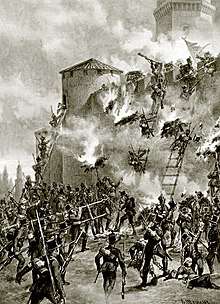
From the late 18th century, Russia actively started to increase its enroachments into Iranian and Turkish territory to the south. Following the annexation of eastern Georgia in 1801, Russia was now keen to conquer the rest of the Iranian possessions in the Caucasus. Russian expansion into the South Caucasus met particularly strong opposition in Ganja. In 1804, the Russians, led by General Pavel Tsitsianov, invaded and sacked Ganja, sparking the Russo-Persian War of 1804–1813.[19] Some western sources assert that "the capture of the city was followed by a massacre of up to 3,000 inhabitants of Ganja by the Russians".[20] They also claim that "500 of them were slaughtered in a mosque where they had taken refuge, after an Armenian told the Russian soldiers that there might have been "Daghestani robbers" among them".[21]
Militarily superior, the Russians ended the Russo-Persian War of 1804–1813 with a victory. By the Treaty of Gulistan that followed, Iran was forced to cede the Ganja Khanate to Russia.[17] The Iranians briefly managed to oust the Russians from Ganja during the 1826 offensive during the Russo-Persian War of 1826–1828, but the resulting Treaty of Turkmenchay made its inclusion into the Russian Empire definite.[22] It was renamed Elisabethpol (Russian: Елизаветполь) after the wife of Alexander I of Russia, Elisabeth, and in 1868 became the capital of Elisabethpol Governorate.[23] Elizavetpol was an uyezd of Tiflis Governorate before 1868. The Russian name was not accepted by Azerbaijanis who continued to call the city Ganja.[24]
20th century
In 1918, Ganja became the temporary capital of the Azerbaijan Democratic Republic, at which point it was renamed Ganja again, until Baku was recaptured from the British backed Centrocaspian Dictatorship. In April 1920, the Red Army occupied Azerbaijan. In May 1920, Ganja was the scene of an abortive anti-Soviet rebellion, during which the city was heavily damaged by fighting between the insurgents and the Red Army.[25] In 1935, Joseph Stalin renamed the city Kirovabad after Sergei Kirov.[26] In 1991, Azerbaijan re-established its independence, and the ancient name of the city was given back. For many years the 104th Guards Airborne Division of the Soviet Airborne Troops was based in the town.[27]
In November 1988, the Kirovabad pogrom forced many Armenians to leave the city.[28][29]
21st century
Reconstruction in the 21st century has led to dramatic changes in the city's urban development, transforming the old Soviet city into a hub of high-rise, mixed-use buildings.[30]
In 2008, Ganja Mausoleum Gates were built on the basis of sketches of ancient Ganja gates made by local master Ibrahim Osman oglu in 1063.[31][32]
Geography
Location
Ganja, located 400–450 meters (1312 to 1476 ft) above the sea level, lies on the Ganja-Gazakh plain in the Kur-Araz lowland in the west of Azerbaijan, 375 km (33 mi) away from Baku. It is situated at the north-eastern foothills of the Lesser Caucasus mountain ranges on the Ganjachay river.[33][34]
The city borders on the administrative rayons of Goygol to the south, west and north-west and Samukh to the north-east.[35]
Climate
Ganja has a semi-arid climate (Köppen climate classification: BSk).
| Climate data for Ganja (1981–2010, extremes 1890–2014) | |||||||||||||
|---|---|---|---|---|---|---|---|---|---|---|---|---|---|
| Month | Jan | Feb | Mar | Apr | May | Jun | Jul | Aug | Sep | Oct | Nov | Dec | Year |
| Record high °C (°F) | 22.8 (73.0) |
25.0 (77.0) |
28.0 (82.4) |
35.6 (96.1) |
39.5 (103.1) |
39.2 (102.6) |
42.0 (107.6) |
41.7 (107.1) |
38.8 (101.8) |
33.4 (92.1) |
28.0 (82.4) |
23.3 (73.9) |
42.0 (107.6) |
| Average high °C (°F) | 7.0 (44.6) |
8.2 (46.8) |
12.7 (54.9) |
18.7 (65.7) |
23.4 (74.1) |
28.7 (83.7) |
31.6 (88.9) |
31.1 (88.0) |
26.3 (79.3) |
19.5 (67.1) |
12.9 (55.2) |
8.4 (47.1) |
19.0 (66.2) |
| Daily mean °C (°F) | 3.2 (37.8) |
3.9 (39.0) |
7.8 (46.0) |
13.4 (56.1) |
18.1 (64.6) |
23.2 (73.8) |
26.2 (79.2) |
25.6 (78.1) |
21.1 (70.0) |
15.0 (59.0) |
8.9 (48.0) |
4.7 (40.5) |
14.3 (57.7) |
| Average low °C (°F) | 0.5 (32.9) |
1.0 (33.8) |
4.3 (39.7) |
9.4 (48.9) |
13.8 (56.8) |
18.6 (65.5) |
21.4 (70.5) |
21.0 (69.8) |
16.8 (62.2) |
11.6 (52.9) |
6.2 (43.2) |
2.1 (35.8) |
10.6 (51.1) |
| Record low °C (°F) | −17.8 (0.0) |
−15.2 (4.6) |
−12.0 (10.4) |
−4.4 (24.1) |
1.5 (34.7) |
5.8 (42.4) |
10.1 (50.2) |
10.5 (50.9) |
2.8 (37.0) |
−1.3 (29.7) |
−7.9 (17.8) |
−13.0 (8.6) |
−17.8 (0.0) |
| Average precipitation mm (inches) | 8 (0.3) |
12 (0.5) |
24 (0.9) |
31 (1.2) |
40 (1.6) |
32 (1.3) |
17 (0.7) |
15 (0.6) |
15 (0.6) |
24 (0.9) |
16 (0.6) |
7 (0.3) |
241 (9.5) |
| Average precipitation days (≥ 0.1 mm) | 7.0 | 7.0 | 8.0 | 8.2 | 9.0 | 7.0 | 4.0 | 3.0 | 4.0 | 6.3 | 6.5 | 6.0 | 76.0 |
| Average rainy days | 3 | 4 | 6 | 8 | 9 | 6 | 4 | 3 | 4 | 6 | 6 | 4 | 63 |
| Average snowy days | 3 | 5 | 2 | 0.2 | 0 | 0 | 0 | 0 | 0 | 0.4 | 1 | 2 | 14 |
| Average relative humidity (%) | 71 | 71 | 68 | 70 | 68 | 61 | 59 | 61 | 65 | 74 | 76 | 74 | 68 |
| Mean monthly sunshine hours | 120 | 113 | 141 | 182 | 229 | 267 | 278 | 252 | 212 | 168 | 123 | 115 | 2,200 |
| Source 1: Deutscher Wetterdienst (sun, 1961–1990)[36][37][lower-alpha 1] | |||||||||||||
| Source 2: Pogoda.ru.net[38] | |||||||||||||
Administrative divisions
Today, Ganja is divided into 2 rayons (administrative districts).[39] The mayor, presently Niyazi Bayramov[40] embodies the executive power of the city.[41][42] Ganja includes 6 administrative settlements, namely Hajikend, Javadkhan, Shixzamanli, Natavan, Mahsati and Sadilli.[43]
Kapaz raion
Kapaz district (Kəpəz rayonu) was established on 21 November 1980 according to the decision of Supreme Soviet of Azerbaijan SSR. The district consists of 2 administrative territorial units and 6 administrative settlements. It has an area of approximately 70 square kilometers (27 sq mi) with the population of 178,000.[44]
Nizami raion
Nizami district (Nizami rayonu) was also established on 21 November 1980 according to the decision of Supreme Soviet of Azerbaijan SSR as Ganja raion of Kirovabad city. When Ganja's historic name was restored and the city was renamed as Ganja instead of Kirovabad in 1989, the district was also renamed as Nizami raion. The district consists of 2 administrative territorial units. The area of the district is roughly 39 square kilometers (15 sq mi) and population is 148,000.[45]
Demographics
| Year | Azerbaijanis | % | Armenians | % | Russians | % | Others 1 | % | TOTAL |
|---|---|---|---|---|---|---|---|---|---|
| 1886[46] | 20,294 | ||||||||
| 1892[47] | 25,758 | ||||||||
| 1897[48] | 33,625 | ||||||||
| 1926[46] | 57,339 | ||||||||
| 1939[49] | 98,494 | ||||||||
| 1959[50] | 116,122 | ||||||||
| 1970[51] | 189,512 | ||||||||
| 1979[52] | 231,066 | ||||||||
| 1999[53] | 299,342 | ||||||||
| 2009[54] | 313,249 | ||||||||
| 1 Georgians, Jews, Ukrainians etc. | |||||||||
Ganja is the third largest city of Azerbaijan after Baku and Sumqayit with about 332,600[55] residents. The city is also inhabited by a large number of Azerbaijani refugees from Armenia and IDPs from the Azerbaijani community of Nagorno-Karabakh and surrounding areas. Their number was estimated to be 33,000 in 2011.[56]
Lezgi people in Ganja number around 20,000.[57]
Historic Armenian community
In addition to Persian and Turkic-speaking Muslims, the city has had a numerically, economically and, culturally significant Christian Armenian. The city's traditional Armenian name is Gandzak (Գանձակ), which derives from gandz (գանձ), a loan word from Old Iranian, which means treasure or riches.[58][59] The founder of the Hethumid dynasty, Oshin of Lampron was an Armenian nakharar and lord of a castle near Ganja who fled to Cilicia in 1075 during the Seljuk invasion of Armenia.[60]
The city's historically important Armenian figures include:
- Mkhitar Gosh, 12th century philosopher,[61] author of the Code of Laws that was used in Armenia, Armenian Kingdom of Cilicia and Armenian diaspora communities in Europe,[62]
- Kirakos Gandzaketsi, a 13th-century historian[63]
- Vardan Areveltsi, 13th century polymath[64]
- Grigor Paron-Ter, Armenian Patriarch of Jerusalem in 1613–45
- Karo Halabyan, Soviet architect[65]
- Askanaz Mravyan, secretary of the Armenian SSR Communist Party[66]
- Abram Alikhanov and Artem Alikhanian, physicists[67]
- Sergei Adian, Soviet mathematician
- Albert Azaryan, artistic gymnast and Olympic champion[68]
Religion

The urban landscape of Ganja is shaped by many communities. The religion with the largest community of followers is Islam. The majority of the Muslims are Shia Muslims, and the Republic of Azerbaijan has the second highest Shia population percentage in the world after Iran.[69] The city's notable mosques include Shah Abbas Mosque, Goy Imam Mosque, Shahsevenler Mosque, Qirikhli Mosque and Qazakhlar Mosque.[70]
There are some other faiths practiced among the different ethnic groups within the country. The other faith worshipping places include Alexander Nevsky Church, German Lutheran Church, Saint John Church and Saint Sarkis Church.[71][72] Before the Kirovabad Pogrom in 1988 a significant community of Armenian Christians existed.
According to the State Statistics Committee, as of 2018, the population of city recorded 332,600 persons, which increased by 31,900 persons (about 10.6 percent) from 300,700 persons in 2000.[73] 162,300 of total population are men, 170,300 are women.[74] More than 26 percent of the population (about 86,500 persons) consists of young people and teenagers aged 14–29.[75]
| Region | 2000 | 2014 | 2015 | 2016 | 2017 | 2018 |
|---|---|---|---|---|---|---|
| Ganja town | 300,7 | 324,7 | 328,4 | 330,1 | 331,4 | 332,6 |
| Nizami region | ... | 149,3 | 150,4 | 151,2 | 151,6 | 152,0 |
| Kapaz region | ... | 175,4 | 178,0 | 178,9 | 179,8 | 180,6 |
Economy
The economy of Ganja is partially agricultural, partially tourist based, with some industries in operation. Ore minerals extracted from nearby mines supply Ganja's metallurgical industries, which produces copper and alumina.[76] There are porcelain, silk and footwear industries. Other industries process food, grapes and cotton from the surrounding farmlands.
The city has one of the largest textile conglomerates in Azerbaijan and is famous for a fabric named Ganja silk, which received the highest marks in the markets of neighboring countries and the Middle East.[77][78]
People are mainly employed in manufacturing, education, transportation, service sectors and catering. "Det.Al-Aluminium" is the largest employer operating in Ganja, followed by Ganja Auto Plant and Ganja Winery Plant 2.[43]
Tourism and shopping

Traditional shops, modern shops and malls create a mixture of shopping opportunities in Ganja. Javad Khan Street is the traditional shopping street that is located in the old town.[79] Constructed between 2014 and 2017,[80] Ganja Mall is considered as the city's largest mall.[81][82] Other shopping centers include Khamsa Park, Taghiyev Mall and Aura Park.[83]
Ganja is one of the famous tourist destinations in Azerbaijan with its historic buildings such as Nizami Mausoleum, Ancient gates, Juma Mosque, Imamzadeh, Tomb of Javad Khan, Chokak Hamam, Shah Abbas Caravanserai and Ugurlu Bay Caravanserai.[84][85][86]
Other tourist and entertainment spots include Javad khan street, Triumphal Arch near Heydar Aliyev Center, the Bottle House, Flag square, Hajikend resort zone.[87] Goygol National Park with the sceneries of lake Goygol, lake Maralgol, Mount Kapaz and Mount Murov are located near Ganja.[88][89]
In 2016, Ganja was selected as the European Youth Capital by the final decision of international jury at the General Assembly of the European Youth Forum.[90] Ganja became the first city to win the title of European Youth Capital among the former Commonwealth Independent States (CIS) and non-EU cities.[91] It was an event with a budget of 5.7 million euros, projected to boost tourism by about one-fifth.[92][93]
Culture
The city has many amenities that offer a wide range of cultural activities, drawing both from a rich local dramatic portfolio and an international repertoire. The city is known for its famous metal handicrafts industry during the Middle Ages. The most notable works of that period includes Gates of Ganja and Ancient Ganja Gate.[94][95][96]
As of 2012, the city along with Baku and Lankaran participates in Earth Hour movement.[97][98]
Museums
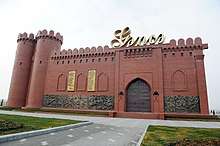
Ganja State History-Ethnography Museum is the oldest museum in the city, with over 30,000 artifacts.[99] The city is also home to Nizami Ganjavi Museum, which was built in 2014.[100] The museum contains a research section, a library, a conference room, and corners for guests and tourists' relaxation.[100]
Other museums include Heydar Aliyev Museum, House Museum of Mir Jalal Pashayev, Memorial House-Museum of Nizami Ganjavi, Memorial-House Museum of İsrafil Mammadov, Ganja branch of Museum of Miniature Books, "Ganja Castle Gates – Archaeology and Ethnography Museum" monument complex, Cultural Center named after Mahsati Ganjavi, Museum of Modern Art and Museum of Mirza Shafi Vazeh.[101][102][103][104][83][105]
Galleries
Ganja State Art Gallery was established in April 1984 according to the decision of Council of Ministers of Azerbaijan SSR. The Gallery is headed by the carpet-artist Faig Osmanov.[106][107]
Architecture
Ganja is primarily known for its Azerbaijani and Islamic architecture, but its buildings reflect the various peoples and empires that have previously ruled the city. During Ganja Khanate period, the Khans proceeded to make an indelible impression on the skyline of Ganja, building towering mosques and houses from red bricks.[108]
Among the oldest surviving examples of Islamic architecture in Ganja are the Nizami Mausoleum and Shah Abbas Caravanserai, which assisted the Shahs during their siege of the city.[109][110] The area around and inside the mosques, contains many fine examples of traditional architecture like Chokak Bath.[111]
Another interesting building is the Bottle house of Ganja.
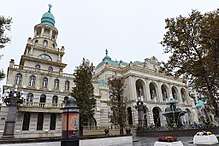
Music and media
Ganja State Philharmonic was established in August 1990 according to the decision of Ministry of Culture of Azerbaijan SSR.[112] On 21 January 2012, president Ilham Aliyev laid the foundation of Ganja State Philharmonic.[113] The facility includes a 1,200 concert hall, an open-air cinema theatre, a drawing gallery, an urban center and an observation tower.[113] The new building of the Philharmonic Hall was put into use in 2017. Goygol State Song and Dance Ensemble, Orchestra of Folk Instruments and Ganja State Chamber Orchestra operate under Ganja State Philharmonic.[112][83]
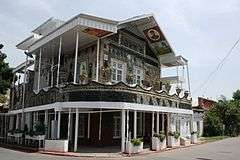 Bottle house in Ganja, a local icon entirely made of glass bottles[114]
Bottle house in Ganja, a local icon entirely made of glass bottles[114]
The two regional channels Kapaz TV and Alternativ TV are headquartered in Ganja.[115] 2 newspapers are published in Ganja ("Gəncənin səsi" and "Novosti Qyandji").[83]
Theaters
Ganja State Drama Theater
The building of the Ganja State Drama Theater was built by the German entrepreneur Christofor Forer in the 1880s. Ganja Drama Theater was established in 1921 in Baku as "Tənqid-təbliğ" (literally means "Criticism-propaganda"). In 1935 the theater moved to Ganja with its staff and continues its activity here under different names until 1990. The Theater has been called Ganja State Drama Theater since 1990.[116]
Ganja State Puppet Theater
Ganja State Puppet Theater was established according to the Decree No.299 of Council of Ministers of Azerbaijan SSR in September 1986. Before receiving "state theater" status in 1986, it was functioning as public theater. Ganja Puppet Theater operates in the building of Lutheran church constructed in 1885 by German settlers.[117][118]
Parks and gardens
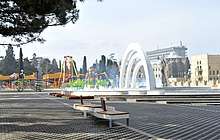
Ganja has many well-maintained parks and gardens, with the Khan's garden being one of the most scenic parks, and one of the city's most known landmarks.[119] It features interesting landscaping, and consists of a wide variety of trees and plants in an open concept.[120]
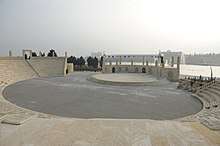
Other prominent parks and gardens include Heydar Aliyev Park Complex, "Ganja 2016 European Youth Capital Park", "Ganja river" park-boulevard complex, Istiglal Avenue, Fikrat Amirov Park, Fuzuli Park, and Narimanov Park.[121] Heydar Aliyev park-complex includes an Amphitheater considered for organizing large outdoor events for up to 5000 people.[122][123]
Sports
The city has one professional football team, Kapaz, currently competing in the second-flight of Azerbaijani football, the Azerbaijan First Division.[124] The club has three Azerbaijani league and four cup titles.
There are Olympic Sports Complex with 2 buildings (put into operation in 2002 and 2006 respectively),[125] Ganja City Stadium with a capacity of 27000[126][127] put into use in 1964 and other sporting facilities in Ganja.[128][129]
İn September 2017 "Ganja Marathon 2017" was organized involving 11000 people from different regions of Azerbaijan, as well as foreigners under the slogan "Be with us in the Marathon". The race started from Triumphal Arch and finished at the Heydar Aliyev Park Complex covering a distance of 17 kilometers.[130][131]
Transportation
Public transport
Ganja has a large urban transport system, mostly managed by the Ministry of Transportation. In 2013, Ministry of Transportation stated that the city, along with Nakhchivan and Sumqayit will have a new subway line within the framework of the 20-year subway program.[132][133] The city had a trolleybus system, functioning from 1955 to 2004.[134]
Ganja is without a tram system since Ganja tramway network ceased in the 1980s.[135]
Air
Ganja International Airport is the only airport in the city.[136] The airport is connected by bus to the city center. There are domestic flights to Baku and international service to Russia and Turkey.
Rail
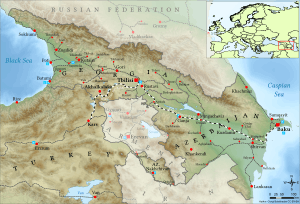
Ganja sits on one of the Azerbaijani primary rail lines running east–west connecting the capital, Baku, with the rest of the country. The Kars–Tbilisi–Baku railway runs along the line through the city. The railway provides both human transportation and transport of goods and commodities such as oil and gravel.
Ganja's Central Railway Station is the terminus for national and international rail links to the city. The Kars–Tbilisi–Baku railway, which directly connects Turkey, Georgia and Azerbaijan, began to be constructed in 2007 and completed in 2017.[137] The completed branch connects Ganja with Tbilisi in Georgia, and from there trains continue to Akhalkalaki, and Kars in Turkey.[138]
Education
The first seminary in Azerbaijan aimed at professional training of school teachers was opened in Ganja in 1914 which was united with Girls Seminary in 1927 and renamed as Ganja Pedagogical Technical School (Azerbaijani: Gəncə Pedoqoji Texnikumu).[139]
Ganja is home to four major institutes for post-secondary education. Ganja State University was founded as Ganja Teachers Institute after Hasan bey Zardabi in 1939.[140] In 2000, the President of Azerbaijan renamed the institute to Ganja State University.[140] The university includes 8 faculty departments and 10 offices.[140] The city also includes Azerbaijan State Agricultural Academy, Azerbaijan Technological University and local branch of Azerbaijan Teachers' Institute.[141]
There are also schools offering secondary specialized education like Ganja Music College, Ganja Medicine College, Ganja State Regional Collage (established by combining Ganja Humanitarian Collage and Ganja Technical College in 2010).[142][143]
There are a total of 7 schools offering vocational education in Ganja, being located as 3 vocational lyceums and a vocational school in Kapaz raion, a vocational lyceum and 2 vocational schools in Nizami raion.[142][144][145]
Notable residents
Because of its intermittent periods of great prosperity as well as being one of the largest cities in Azerbaijan and one of the most ethnically and culturally diverse in the Caucasus, Ganja prides itself on having produced a disproportionate number of notable figures in the sciences, arts and other fields. Some of the houses they resided in display commemorative plaques. Some of the many prestigious residents include: poet Nizami Ganjavi, scientist Firuddin Babayev, Olympic champion Toghrul Asgarov, ruler of Ganja Khanate Javad Khan, poets Mirza Shafi Vazeh, Mahsati Ganjavi, Nigar Rafibeyli, writer Ibn Khosrov al-Ustad, composer Fikrat Amirov, historian Farid Alakbarli and prime minister of Azerbaijan Artur Rasizade.
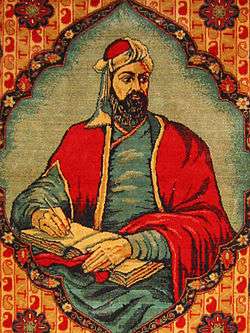 Nizami Ganjavi, the author of "Khamsah[146]", considered as one of Middle East's greatest poets.
Nizami Ganjavi, the author of "Khamsah[146]", considered as one of Middle East's greatest poets.- Nasib Yusifbeyli, was major political figure in Azerbaijan Democratic Republic.
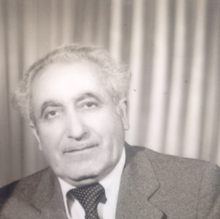 Firuddin Babayev, Azerbaijani and Soviet scientist, Azerbaijan's first professor-plant pathologist, doctor of biological sciences.
Firuddin Babayev, Azerbaijani and Soviet scientist, Azerbaijan's first professor-plant pathologist, doctor of biological sciences.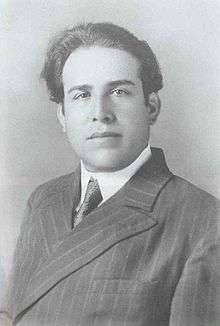 Mirali Qashqai, was an eminent Azerbaijani geologist, author of multitude works in the sphere of geomorphology and stratigraphy.
Mirali Qashqai, was an eminent Azerbaijani geologist, author of multitude works in the sphere of geomorphology and stratigraphy. Mirza Shafi Vazeh, continued the classical traditions of Azerbaijani poetry from the 14th century.
Mirza Shafi Vazeh, continued the classical traditions of Azerbaijani poetry from the 14th century.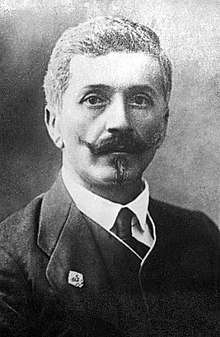 Hasan bey Aghayev, served as the Deputy Speaker of National Assembly of Azerbaijan Democratic Republic.
Hasan bey Aghayev, served as the Deputy Speaker of National Assembly of Azerbaijan Democratic Republic.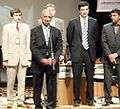 Faiq Hasanov, known as International Arbiter of chess and television presenter of weekly Chess Club programme.
Faiq Hasanov, known as International Arbiter of chess and television presenter of weekly Chess Club programme. Mahsati, persecuted for her courageous poetry condemning religious fanaticism and dogmas.
Mahsati, persecuted for her courageous poetry condemning religious fanaticism and dogmas.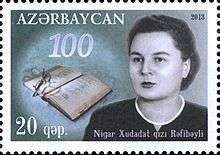 Nigar Rafibeyli, writer and the Chairman of the Writers' Union in Azerbaijan.
Nigar Rafibeyli, writer and the Chairman of the Writers' Union in Azerbaijan.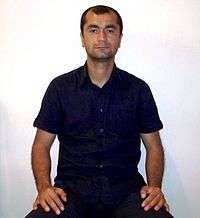
International relations
Twin towns – Sister cities
Ganja is twinned with various cities.[148]






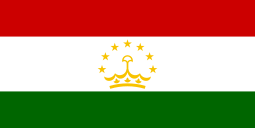














Notes
- Station ID for Gandja is 37735 Use this station ID to locate the sunshine duration
References
- State Statistical Committee of the Republic of Azerbaijan, Official Publication: Statistical Yearbook of Azerbaijan 2018, Baku
- Azərbaycan Respublikası. — 2. Azərbaycan Respublikasının iqtisadi və inzibati rayonları. — 2.4. Azərbaycan Respublikasının iqtisadi və inzibati rayonlarının ərazisi, əhalisinin sayı və sıxlığı, səhifə 66. // Azərbaycanın əhalisi (statistik bülleten). Müəllifi: Azərbaycan Respublikasının Dövlət Statistika Komitəsi. Buraxılışa məsul şəxs: Rza Allahverdiyev. Bakı — 2015, 134 səhifə.
- Bölmə 2: Demoqrafik göstəricilər, səhifə 89. // Azərbaycanın Statistik Göstəriciləri 2015 (statistik məcmuə). Müəllifi: Azərbaycan Respublikası Dövlət Statistika Komitəsi. Məcmuənin ümumi rəhbəri: Həmid Bağırov; Məcmuənin hazırlanması üçün məsul şəxs: Rafael Süleymanov. Bakı – 2015, 814 səhifə.
- Encyclopedia Iranica, "Ganja", C. Edmund Bosworth Archived 10 January 2012 at the Wayback Machine
- Chisholm, Hugh, ed. (1911). . Encyclopædia Britannica. 9 (11th ed.). Cambridge University Press. p. 280.
- Ростислав Борисовч Рыбаков (1995). Восток в средние века. ISBN 978-5-02-017711-6.
- Дьяконов, Игорь Михайлович. Книга воспоминаний. Издательство "Европейский дом", Санкт-Петербург, 1995., 1995 Archived 22 April 2008 at the Wayback Machine. – ISBN 978-5-85733-042-5. cтр. 730–731 Igor Diakonov. The book of memoirs.
- "V.Minorsky. A History of Shirvan and Derbent". Archived from the original on 26 September 2007. Retrieved 10 September 2007.
- History of the Caucasian Albanians by Movses Dasxuranci, C.J.F. Dowsett trans. (London 1961), chapter 21.
- "Iran. (2007). In Encyclopædia Britannica. Retrieved March 17, 2007". Archived from the original on 19 February 2007. Retrieved 17 March 2007.
- "Timurid Dynasty. (2007). In Encyclopædia Britannica. Retrieved March 16, 2007". Archived from the original on 2 September 2007. Retrieved 17 March 2007.
- "Kara Koyunlu. (2007). In Encyclopædia Britannica. Retrieved March 15, 2007". Archived from the original on 29 October 2007. Retrieved 17 March 2007.
- "Ak Koyunlu. (2007). In Encyclopædia Britannica. Retrieved March 17, 2007". Archived from the original on 30 September 2007. Retrieved 17 March 2007.
- "Aznet.org: Ganja's History". Archived from the original on 29 March 2007. Retrieved 17 March 2007.
- Tadeusz Swietochowski. Russian Azerbaijan 1905–1920: The Shaping of National Identity in a Muslim Community. Cambridge, UK, Cambridge University Press, 2004. ISBN 0-521-52245-5
- "History of Azerbaijan" Archived 18 November 2008 at the Wayback Machine Encyclopædia Britannica Online
- Timothy C. Dowling (2014). Russia at War: From the Mongol Conquest to Afghanistan, Chechnya, and Beyond. ABC-CLIO. p. 728. ISBN 978-1-59884-948-6.
- Seyyaf Sednik oqli Pashayev. "The Monuments of Ganja Khanate of the Period form 1606–1804". Archived from the original on 3 July 2007. Retrieved 16 February 2007.
- Tucker, Spencer C., ed. (2010). A Global Chronology of Conflict: From the Ancient World to the Modern Middle East. ABC-CLIO. p. 1035. ISBN 978-1851096725.
January 1804. (...) Russo-Persian War. Russian invasion of Persia. (...) In January 1804 Russian forces under General Paul Tsitsianov (Sisianoff) invade Persia and storm the citadel of Ganjeh, beginning the Russo-Persian War (1804-1813).
- Peter Avery; William Bayne Fisher; Gavin Hambly; Charles Melville (25 October 1991). The Cambridge history of Iran: From Nadir Shah to the Islamic Republic. Cambridge University Press. p. 332. ISBN 978-0-521-20095-0.
- John F. Baddeley, The Russian Conquest of the Caucasus, London: Longmans, Green and Co., 1908, p. 67, citing "Tsitsianoff's report to the Emperor: Akti, ix (supplement), p. 920".
- Timothy C. Dowling (2014). Russia at War: From the Mongol Conquest to Afghanistan, Chechnya, and Beyond. ABC-CLIO. pp. 728–729. ISBN 978-1-59884-948-6.
- Елизаветпольская губерния Archived 11 September 2011 at the Wayback Machine (Elizavetpol Governorate) in Brockhaus and Efron Encyclopedic Dictionary (in Russian)
- Tadeusz Swietochowski (2004). Russian Azerbaijan, 1905–1920: The Shaping of a National Identity in a Muslim Community. Cambridge University Press. ISBN 978-0-521-52245-8.
- Charles van der Leeuw (4 July 2000). Azerbaijan: a quest for identity : a short history. Palgrave Macmillan. p. 124. ISBN 978-0-312-21903-1.
- Gəncənin tarixi... Archived 16 July 2011 at the Wayback Machine (in Azerbaijani)
- "31-я гвардейская отдельная воздушно-десантная ордена Кутузова II степени бригада". www.bratishka.ru (in Russian). Archived from the original on 29 November 2014. Retrieved 17 November 2014.
- Imogen Gladman (2004). Eastern Europe, Russia and Central Asia. Taylor & Francis Group. pp. Page 131. ISBN 1-85743-316-5.
- Stuart J. Kaufman (2001). Modern Hatreds: The Symbolic Politics of Ethnic War. Cornell University Press. p. 77. ISBN 0-8014-8736-6.
- На дороге Баку-Газах возводятся грандиозные "Гянджинские ворота" – ФОТО. Day.az (in Russian). 17 January 2013. Archived from the original on 23 January 2013. Retrieved 15 April 2013.
- "Ilham Aliyev reviewed the monumental complex Ganja Fortress Gates – the Museum of Archeology and Ethnography". en.president.az. Archived from the original on 12 November 2014. Retrieved 12 November 2014.
- "Gəncə qapıları". www.heydar-aliyev-foundation.org. Archived from the original on 12 November 2014. Retrieved 12 November 2014.
- "Location". Executive Power of Ganja. Archived from the original on 21 August 2018. Retrieved 21 August 2018.
- "Location". Ministry of Culture of Azerbaijan – Ganja Regional Culture Office. Archived from the original on 21 August 2018. Retrieved 21 August 2018.
- "Political-administrative Map of Azerbaijan". Ministry of Foreign Affairs of Azerbaijan. Archived from the original on 10 May 2017. Retrieved 21 August 2018.
- "Klimatafel von Gjandscha (Kirowabad/Elisawetpol) / Aserbaidschan" (PDF). Baseline climate means (1961–1990) from stations all over the world (in German). Deutscher Wetterdienst. Retrieved 29 September 2016.
- "Station 37735 Gandja". Global station data 1961–1990—Sunshine Duration. Deutscher Wetterdienst. Archived from the original on 17 October 2017. Retrieved 29 September 2016.
- "Weather and Climate- The Climate of Ganja" (in Russian). Weather and Climate (Погода и климат). Archived from the original on 10 October 2016. Retrieved 9 October 2016.
- "Üfüqdən boylanan şəhər". anl.az (in Azerbaijani). Archived from the original on 12 November 2014. Retrieved 12 November 2014.
- "İcra hakimiyyətinin başçısı – GƏNCƏ ŞƏHƏR Icra Hakimiyyəti". ganja-ih.gov.az. Archived from the original on 30 November 2018. Retrieved 29 November 2018.
- "Elmar Valiyev's Biography". www.nizamiganjavi-ic.org. Archived from the original on 12 November 2014. Retrieved 12 November 2014.
- "Ganja mayor reassigned to Sumgayit". www.azernews.az. 19 February 2011. Archived from the original on 12 November 2014. Retrieved 12 November 2014.
- "Economy". Executive Power of Ganja. Archived from the original on 21 August 2018. Retrieved 21 August 2018.
- "About Kapaz raion of Ganja". Kapaz District Executive Power. Archived from the original on 21 August 2018. Retrieved 21 August 2018.
- "About Nizami raion of Ganja". Nizami District Executive Power. Archived from the original on 21 August 2018. Retrieved 21 August 2018.
- (in Russian) Ethno-Caucasus: Азербайджан Archived 28 March 2012 at the Wayback Machine
- "Елисаветополь в Энциклопедическом словаре Брокгауза и Ефрона". Archived from the original on 29 November 2011. Retrieved 10 December 2011.
- (in Russian) Демокоп Weekly Archived 7 January 2016 at the Wayback Machine г. Елисаветполь
- (in Russian) Ethno-Caucasus: КИРОВАБАДСКИЙ ГОРСОВЕТ (1939 г.) Archived 28 March 2012 at the Wayback Machine
- (in Russian) Ethno-Caucasus: КИРОВАБАДСКИЙ ГОРСОВЕТ (1959 г.) Archived 25 April 2012 at the Wayback Machine
- (in Russian) Ethno-Caucasus: КИРОВАБАДСКИЙ ГОРСОВЕТ (1970 г.) Archived 27 May 2012 at the Wayback Machine
- (in Russian) Ethno-Caucasus: КИРОВАБАДСКИЙ ГОРСОВЕТ (1979 г.) Archived 9 June 2012 at the Wayback Machine
- "Ethnic composition of Azerbaijan 1999". Archived from the original on 29 July 2013. Retrieved 4 January 2012.
- "Ethnic composition of Azerbaijan 2009". Archived from the original on 7 February 2012. Retrieved 4 January 2012.
- "Statistical Yearbook of 2018". State Statistical Committee of the Republic of Azerbaijan. Archived from the original on 7 February 2019. Retrieved 5 February 2019. Cite journal requires
|journal=(help) - "Ganja City Executive Power official web page, retrieved 9 March 2012". Archived from the original on 24 January 2012. Retrieved 9 March 2012.
- Герейханов, Гаджи Пирмурадович; Лукьянов, Алексей Григорьевич; Моренов, Игорь Сергеевич (2004). Угрозы национальной безопасности России на Северном Кавказе: этноконфессиональный аспект. Граница.
- Philological Society (Great Britain) (1956). Transactions of the Philological Society. Philological Society (Great Britain). Published for the Society by B. Blackwell. p. 100.
- "Dictionary.Hayastan.com". Archived from the original on 18 March 2008. Retrieved 24 October 2007.
- M. Setton, Kenneth; Robert Lee Wolff; Harry W. Hazard (24 March 2006). "XVIII: The Kingdom of Cilician Armenia". The later Crusades, 1189–1311 (A History of the Crusades, volume, II). Madison, Wisconsin: University of Wisconsin Press. p. 633. ISBN 978-0-299-04844-0. Archived from the original on 2 December 2008. Retrieved 17 October 2008.
- Mkhitar Gosh at BSE
- "Despite the code of Gosh not having official standing, it was used in Armenia, as in other countries with Armenian populations."Code of Laws by Gosh at Great Soviet Encyclopedia (BSE)
- Kirakos, Gandzaketsi, History of the Armenians, New York: Sources of the Armenian Tradition, 1986.
- (in Armenian) Hovhannisyan, P. «Վարդան Արևելցի» (Vardan Areveltsi). Soviet Armenian Encyclopedia. vol. xi. Yerevan, Armenian SSR: Armenian Academy of Sciences, 1985, pp. 312–313.
- Alabyan at BSE
- Mravyan at BSE
- Artem Alikhanian: the father of Armenian physics Archived 21 January 2015 at the Wayback Machine, CERN Courier, Vol. 48, N. 6, 2008, p. 41
- Azarian at BSE
- Juan Eduardo Campo,Encyclopedia of Islam, p.625
- "Azərbaycanda məscidlərin sayı 40 dəfə artıb". oxu.az (in Azerbaijani). 12 September 2013. Archived from the original on 12 November 2014. Retrieved 12 November 2014.
- Георгий Заплетин, Гюльнара Ширин-заде (2008). Русские в истории Азербайджана. Ганун.
- "Nor-Dar," 1889, No. 85, p. 2
- "Political division, population size and structure: Population by towns and regions of the Republic of Azerbaijan". The State Statistical Committee of the Republic of Azerbaijan. Archived from the original on 27 August 2018. Retrieved 18 December 2018.
- "Political division, population size and structure: Population by sex, towns and regions, urban settlements of the Republic of Azerbaijan at the beginning of the 2018". The State Statistical Committee of the Republic of Azerbaijan. Archived from the original on 27 August 2018. Retrieved 18 December 2018.
- "Political division, population size and structure: Population at age 14–29 by towns and regions of the Republic of Azerbaijan at the beginning of the 2018". The State Statistical Committee of the Republic of Azerbaijan. Archived from the original on 27 August 2018. Retrieved 18 December 2018.
- "Ganja on Cities & Sites". Archived from the original on 16 July 2011. Retrieved 31 January 2010.
- "Ministry of Culture and Tourism of the Republic of Azerbaijan: Ganja's History". Archived from the original on 9 March 2016. Retrieved 23 April 2019.
- Gəncə Dövlət Universitetinin Riyaziyyat-İnformatika fakültəsi: GƏNCƏNİN TARİXİ Archived 24 August 2010 at the Wayback Machine (in Azerbaijani)
- "Beşikdən qəbirədək dəyişən Gəncə". www.anspress.com. Archived from the original on 12 November 2014. Retrieved 12 November 2014.
- "Gəncə Mall". GanjaNews.az (in Azerbaijani). Archived from the original on 21 August 2018. Retrieved 21 August 2018.
- "Gəncədə nəhəng ticarət mərkəzi tikilir". www.regionsesi.az (in Azerbaijani). Archived from the original on 12 November 2014. Retrieved 12 November 2014.
- "Ganja Mall". worldarchitecture.org. Archived from the original on 21 August 2018. Retrieved 21 August 2018.
- "About the city". Executive Power of Ganja. Archived from the original on 21 August 2018. Retrieved 21 August 2018.
- "Historical monuments". Ministry of Culture of Azerbaijan – Ganja Regional Culture Office. Archived from the original on 21 August 2018. Retrieved 21 August 2018.
- "Subordinate organizations". Ministry of Culture of Azerbaijan – Ganja Regional Culture Office. Archived from the original on 21 August 2018. Retrieved 21 August 2018.
- "Cultural Heritage of Ganja". Ganja City Central Library. Archived from the original on 21 August 2018. Retrieved 21 August 2018.
- "Architectural monuments of local significance". Official website of Ganja city (in Azerbaijani). Archived from the original on 21 August 2018. Retrieved 21 August 2018.
- "Goygol Lake opens its natural beauty to tourists". AzerNews.az. 11 August 2015. Archived from the original on 21 August 2018. Retrieved 21 August 2018.
- "About Ganja". Ministry of Culture of Azerbaijan – Ganja Regional Culture Centre. Archived from the original on 21 August 2018. Retrieved 21 August 2018.
- FS. "Ganja – "European Youth Capital 2016"". mfa.gov.az. Archived from the original on 30 November 2018. Retrieved 29 November 2018.
- FS. "Ganja – "European Youth Capital 2016"". mfa.gov.az. Archived from the original on 30 November 2018. Retrieved 29 November 2018.
- "Ganja is European Youth Capital 2016!". www.yeu-international.org. Archived from the original on 18 December 2014. Retrieved 17 November 2014.
- "Ganja, European Youth Capital 2016". www.youthforum.org. Archived from the original on 25 December 2014. Retrieved 17 November 2014.
- "Gəncə darvazası". www.gencekitab.az (in Azerbaijani). Archived from the original on 12 November 2014. Retrieved 12 November 2014.
- "Ganja gates". eurotourism.az. Archived from the original on 12 November 2014. Retrieved 12 November 2014.
- "Ворота древней Гянджи". advantour. Archived from the original on 12 November 2014.
- "Azerbaijan to join Earth Hour". www.news.az. Archived from the original on 29 November 2014. Retrieved 17 November 2014.
- "IDEA campaign to hold Earth Hour action". en.trend.az. 30 March 2012. Archived from the original on 29 November 2014. Retrieved 17 November 2014.
- N.Gəncəvi adına Gəncə Dövlət Tarix-Diyarşünaslıq Muzeyi Archived 7 December 2016 at the Wayback Machine, gence.az
- "Nizami Ganjavi Museum in Ganja". www.heydar-aliyev-foundation.org. Archived from the original on 12 November 2014. Retrieved 12 November 2014.
- "Museums". Azerbaijan State News Agency. Archived from the original on 21 August 2018. Retrieved 21 August 2018.
- "Culture". Ministry of Culture of Azerbaijan – Ganja Regional Culture Office. Archived from the original on 21 August 2018. Retrieved 21 August 2018.
- "Miniatür Kitab Muzeyinin Gəncə filialı açılıb". AZERBAIJAN STATE NEWS AGENCY (in Azerbaijani). Archived from the original on 23 May 2016. Retrieved 21 August 2018.
- "Ilham Aliyev reviewed the monumental complex Ganja Fortress Gates – the Museum of Archeology and Ethnography". Official website of the President of Azerbaijan. Archived from the original on 27 August 2018. Retrieved 21 August 2018.
- "lham Aliyev attended inauguration of Mirza Shafi Vazeh Museum in Ganja". Official website of the President of Azerbaijan. Archived from the original on 15 November 2017. Retrieved 21 August 2018.
- "Ganja State Art Gallery". Culture portal of the Ministry of Culture of Azerbaijan. Archived from the original on 26 September 2018. Retrieved 26 September 2018.
- "Ganja State Art Gallery". Ministry of Culture of Azerbaijan – Ganja Regional Culture Office. Archived from the original on 26 September 2018. Retrieved 26 September 2018.
- "Ganja's Touristic Outlook". discoverazerbaijan.az. Archived from the original on 23 October 2013. Retrieved 12 November 2014.
- Peter J. Chelkowski. Mirror of the invisible world: Tales from the Khamseh of Nizami. Metropolitan Museum of Art, 1975. ISBN 0-87099-142-6, ISBN 978-0-87099-142-4, p. 3
- "Ganja writes history". www.euronews.com. Archived from the original on 12 November 2014. Retrieved 12 November 2014.
- Rafiqqizi, Gulnur. "Gəncədə 400 yaşlı "Çökək hamam" sauna olacaq, yoxsa muzey..." www.azadliq.org (in Azerbaijani). Archived from the original on 12 November 2014. Retrieved 12 November 2014.
- "Fikrat Amirov Ganja State Philharmonic". Ministry of Culture of Azerbaijan – Ganja Regional Culture Office. Archived from the original on 24 September 2018. Retrieved 26 September 2018.
- "Azerbaijani president reviews progress of construction at Ganja State Philharmonic (PHOTO)". en.trend.az. Archived from the original on 12 November 2014. Retrieved 12 November 2014.
- "Bottle House of Ganja". Atlas Obscura. Archived from the original on 30 November 2018. Retrieved 29 November 2018.
- "Radio-TV yayımı" (in Azerbaijani). Archived from the original on 27 October 2014. Retrieved 13 November 2014.
- "Ganja State Drama Theater". Ministry of Culture of Azerbaijan – Ganja Regional Culture Office. Archived from the original on 26 September 2018. Retrieved 26 September 2018.
- "Ganja State Puppet Theater". Ministry of Culture of Azerbaijan – Ganja Regional Culture Office. Archived from the original on 26 September 2018. Retrieved 26 September 2018.
- "State Theatres". Theatre of Azerbaijan. Archived from the original on 26 September 2018. Retrieved 22 May 2017.
- "Gəncədə bağı kim salıb: xan, yoxsa sərdar?". www.azadliq.org (in Azerbaijani). Archived from the original on 12 November 2014. Retrieved 12 November 2014.
- Sadigov, Hasanbala. "The Khan's Garden in Ganja". www.visions.az. Archived from the original on 20 September 2014. Retrieved 12 November 2014.
- "Subordinate organizations – parks". Ministry of Culture of Azerbaijan – Ganja Regional Culture Office. Archived from the original on 21 August 2018. Retrieved 21 August 2018.
- "Amphitheater in Ganja". Yeni Gəncə (in Azerbaijani). 11 July 2017. Archived from the original on 26 September 2018. Retrieved 26 September 2018.
- "Amphitheater in Heydar Aliyev park-complex". Ganja Heydar Aliyev Center. Archived from the original on 26 September 2018. Retrieved 26 September 2018.
- Гянджа сегодня Archived 6 September 2008 at the Wayback Machine (in Russian)
- "Olympic Facilities". Ministry of Youth and Sport of Azerbaijan. Archived from the original on 21 August 2018. Retrieved 21 August 2018.
- "Ganja City Stadium". www.thefootballstadiums.com. Archived from the original on 21 August 2018. Retrieved 21 August 2018.
- "Ganja City Stadium – Football Stadium". Football-Lineups. Archived from the original on 21 August 2018. Retrieved 21 August 2018.
- "Sport". Executive Power of Ganja. Archived from the original on 21 August 2018. Retrieved 21 August 2018.
- "Sports". Kapaz District Executive Power. Archived from the original on 21 August 2018. Retrieved 21 August 2018.
- "Ganja Marathon 2017". Ganja Marathon 2017. Archived from the original on 5 July 2018. Retrieved 21 August 2018.
- "Ganja Marathon-2017". MENAFN News. Archived from the original on 21 August 2018. Retrieved 21 August 2018.
- "Subway to be constructed in Sumgayit, Nakhchivan and Ganja". en.apa.az. Archived from the original on 7 January 2016. Retrieved 10 November 2014.
- "Subways to open in major Azerbaijani cities". www.azernews.az. Archived from the original on 10 November 2014. Retrieved 10 November 2014.
- "13. Гянджа (Кировабад) (троллейбус)" [Vândža (Kirovabad) (trolleybus)]. Горэлектротранс (Electrotrans) website (in Russian). Дмитрий Зиновьев (Dmitry Zinoviev). Archived from the original on 31 January 2013. Retrieved 24 September 2012.
- "Tramways to be laid in Azerbaijan's Ganja". news.az. Archived from the original on 9 November 2014. Retrieved 9 November 2014.
- Gəncə Beynəlxalq hava limanının açılış mərasimi Archived 13 July 2011 at the Wayback Machine (in Azerbaijani)
- "Azerbaijani FM: Baku-Tbilisi-Kars railroad to be built in 2012". trend.az. Archived from the original on 18 October 2010. Retrieved 26 January 2011.
- Railway Gazette International February 2009 p54 with map
- Azerbaijan National Academy of Sciences (2008). Mahmud Ismayilov, Nigar Maksvel (ed.). The history of Azerbaijan (1900–1920) in 7 volumes (PDF) (in Azerbaijani). 5. Baku: Elm. p. 165. ISBN 978-9952-448-41-2. Archived (PDF) from the original on 17 May 2018. Retrieved 21 August 2018.
- "Ganja State University". www.salto-youth.net. Archived from the original on 12 November 2014. Retrieved 12 November 2014.
- "Ali təhsil müəssisələrinin siyahısı". www.edu.gov.az (in Azerbaijani). Archived from the original on 12 November 2014. Retrieved 12 November 2014.
- "Education". Ministry of Culture of Azerbaijan – Ganja Regional Culture Office. Archived from the original on 21 August 2018. Retrieved 21 August 2018.
- "Decision of Cabinet of Ministers dated 15 July 2011". Ministry of Education of Azerbaijan (in Azerbaijani). Archived from the original on 21 August 2018. Retrieved 21 August 2018.
- "Education". Nizami District Executive Power. Archived from the original on 21 August 2018. Retrieved 21 August 2018.
- "Education". Kapaz District Executive Power. Archived from the original on 21 August 2018. Retrieved 21 August 2018.
- "Khamsah of Nizami". The British Library. Archived from the original on 29 October 2016. Retrieved 29 November 2018.
- Махмуд Гурбанов: Это словно первое чемпионство (in Russian). Archived from the original on 11 November 2014. Retrieved 11 November 2014.
- "Twin-cities of Azerbaijan". Azerbaijans.com. Archived from the original on 9 August 2013. Retrieved 9 August 2013.
- "BAKÜ-İZMİR DOSTLUK KÖPRÜSÜNE BİR TUĞLA DAHA". www.izmir.bel.tr (in Turkish). Archived from the original on 12 November 2014. Retrieved 12 November 2014.
- "Kars-Gence kardeş şehir". arsiv.zaman.com.tr (in Turkish). Archived from the original on 12 November 2014. Retrieved 12 November 2014.
- НЬЮ-АРК И ГЯНДЖА СТАЛИ ГОРОДАМИ-ПОБРАТИМАМИ (in Russian). Archived from the original on 12 November 2014. Retrieved 12 November 2014.
- Гянджа и Днепропетровск станут городами-побратимами. www.regnum.by (in Russian). Archived from the original on 12 November 2014. Retrieved 12 November 2014.
- "Gaziantep'in 4 kardeşi daha oldu". www.gaziantepgundem.com (in Turkish). Archived from the original on 13 November 2012. Retrieved 12 November 2014.
- Гянджа и Оломоуц стали городами-побратимами – ФОТО. www.1news.az (in Russian). Archived from the original on 17 December 2014. Retrieved 12 November 2014.
- Худжанд и Гянджа стали городами побратимами. www.avesta.tj (in Russian). Archived from the original on 23 September 2015. Retrieved 12 November 2014.
- "Gəncə ilə Eskişehir qardaş oldu". az.azvision.az (in Azerbaijani). Archived from the original on 12 November 2014. Retrieved 12 November 2014.
- "Ganja Tabriz Sister Cities". Archived from the original on 14 February 2015. Retrieved 14 February 2015.
External links
| Wikivoyage has a travel guide for Ganja. |
| Wikisource has the text of the 1911 Encyclopædia Britannica article Elisavetpol (town). |
| Wikimedia Commons has media related to Ganja. |
- City administration
- Ganja at the Azerbaijan Development Gateway
- Imamzadeh Mausoleum, Ganja
- Ganja (as Gəncə) at GEOnet Names Server
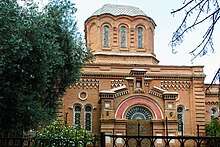
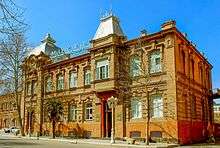
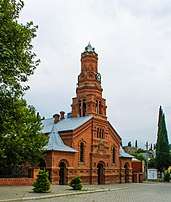
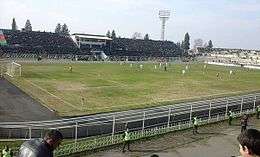
_(semi-secession).svg.png)
